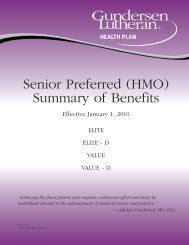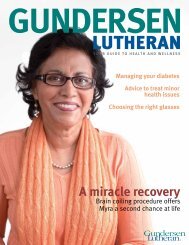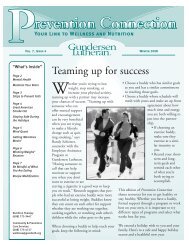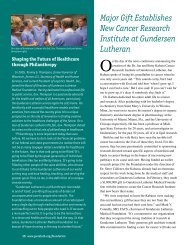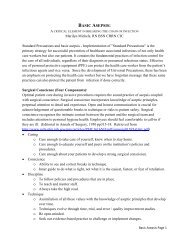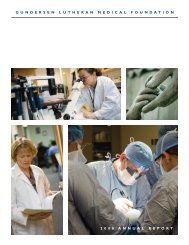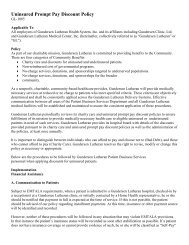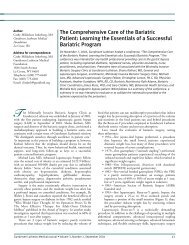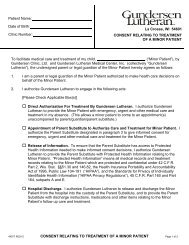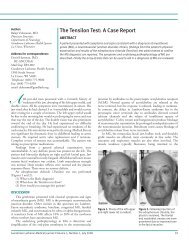Fertility Center helps couple realize dream - Gundersen Health System
Fertility Center helps couple realize dream - Gundersen Health System
Fertility Center helps couple realize dream - Gundersen Health System
You also want an ePaper? Increase the reach of your titles
YUMPU automatically turns print PDFs into web optimized ePapers that Google loves.
Vol. 8, No. 4<br />
‘My child is<br />
sick. Where<br />
should we go?’<br />
Heart care<br />
from the<br />
inside out<br />
Treating<br />
prostate<br />
cancer with<br />
precision<br />
<strong>Fertility</strong> <strong>Center</strong> <strong>helps</strong><br />
<strong>couple</strong> <strong>realize</strong> <strong>dream</strong><br />
The Olson family expands by two
I’m part of something<br />
Your cancer treatment is incredibly personal.<br />
So is your relationship with <strong>Gundersen</strong> Lutheran. We treat you as something<br />
greater than a patient – a partner in your care. Because you support a national leader in<br />
breast cancer treatment and outcomes. And you advance one of the nation’s first centers<br />
to offer a MammoSite TM Radiation Therapy <strong>System</strong> for shorter treatments.<br />
At <strong>Gundersen</strong> Lutheran, your greatest triumphs are also ours.<br />
That’s what personal relationships are all about.<br />
For more information or to find a physician, contact <strong>Gundersen</strong> Lutheran at (800) 362-9567 or visit us at gundluth.org
Helping adults bite, chew<br />
and smile with delight<br />
By Jill Miesen<br />
For the average person, a perfect smile is hard to come by, especially since many of<br />
us are born with mouths too small for our teeth, jaws that aren’t the same size or<br />
crooked teeth which we simply inherit.<br />
<strong>Gundersen</strong> Lutheran orthodontic specialists Michael Barba, DDS, MS, and John<br />
Patterson, DDS, agree the beauty of this problem is that tooth and jaw alignment can<br />
be corrected at any age.<br />
“There used to be a perception that braces are for kids, but today, we are treating<br />
a greater percentage of adults,” explains Dr. Barba.<br />
Whether you have difficulty chewing, biting or cleaning your teeth; crowded,<br />
misplaced or protruding teeth; jaws that shift or make sounds; or the tendency<br />
to bite the cheek or roof of the mouth or grind your teeth, Drs. Barba and<br />
Patterson can help.<br />
Unlike general dentists, orthodontic specialists complete two to three<br />
years of specialized training in tooth movement and facial development so<br />
they can help you find the smile you’ve been seeking by bringing your teeth,<br />
lips and jaws into proper alignment.<br />
There are many advantages to seeking orthodontic<br />
treatment. Straight teeth help individuals bite,<br />
chew and speak effectively, and also contribute<br />
to healthier teeth and gums for a lifetime. In<br />
addition, properly aligned teeth and jaws may<br />
prevent more serious complications such as<br />
Temporomandibular joint (TMJ) syndrome<br />
which causes headache and neck pain. Finally,<br />
self-esteem often improves when individuals are<br />
confident with the appearance of their smile.<br />
Ideally, the American Association of<br />
Orthodontists recommends that children see an<br />
orthodontist no later than age 7. “This allows us to<br />
diagnose and treat improper bite and jaw relationships<br />
early, in the least extensive way possible,” says Dr. Barba.<br />
“However, we offer the most up-to-date and successful<br />
treatments for adults including fixed ceramic appliances<br />
(clear brackets) and Invisalign® to straighten teeth. We<br />
also make referrals to our colleagues in the Department of<br />
Dental Specialists if you require more comprehensive care.”<br />
If you have questions or would like to schedule an<br />
appointment, call (608) 775-2202 or (800) 362-9567,<br />
ext. 52202 for La Crosse or (608) 775-8152 or (800)<br />
362-9567, ext. 58152 for Onalaska. <strong>Gundersen</strong> Lutheran<br />
Orthodontics also offers outreach services in Prairie du<br />
Chien and Tomah, Wis., and Decorah, Iowa..<br />
Visit us online: gundluth.org 3
4 Visit us online: gundluth.org<br />
“I wasn’t expecting in-vitro<br />
fertilization to work because<br />
of all our earlier failures, so<br />
I wouldn’t allow myself to<br />
believe it until I was holding<br />
the babies in my arms.”
<strong>Fertility</strong> <strong>Center</strong> <strong>helps</strong> <strong>couple</strong><br />
<strong>realize</strong> <strong>dream</strong><br />
By Janet Yearous<br />
Seven miscarriages and three<br />
ectopic pregnancies left Sarah<br />
and Bill Olson frustrated and<br />
discouraged. Their <strong>dream</strong>s of having<br />
children had all but vanished.<br />
In one final desperate hope, the<br />
Viroqua <strong>couple</strong> met with fertility expert<br />
Kathy Trumbull, MD, the reproductive<br />
endocrinologist at the <strong>Gundersen</strong><br />
Lutheran <strong>Fertility</strong> <strong>Center</strong>. Dr. Trumbull<br />
suggested the best option for the Olsons<br />
would be in-vitro fertilization (IVF).<br />
“IVF is the best known assisted<br />
reproductive procedure. Eggs collected<br />
from the woman’s ovaries and sperm<br />
from the man are joined in the lab to<br />
form embryos. Usually, two, sometimes<br />
three, embryos are transferred to the<br />
woman’s uterus. The body takes over<br />
from there to hopefully establish a<br />
pregnancy,” Dr. Trumbull explains.<br />
“Dr. Trumbull and her staff<br />
understood our frustrations and helped<br />
us explore all our options. IVF was our<br />
final realistic shot at having children,”<br />
recall Bill and Sarah.<br />
“As anxious as we were to get<br />
pregnant, Dr. Trumbull transferred only<br />
two embryos. I appreciated her caution,”<br />
says Sarah. Dr. Trumbull adds, “Our<br />
goal is to get good single pregnancies<br />
by transferring fewer embryos. There is<br />
a much lower risk for pre-term delivery<br />
and other complications with single<br />
pregnancies than multiples. Last year<br />
our percentage of transfers resulting<br />
in live births for women 35 years<br />
old and younger was 65.5, much<br />
higher than the 46.1 percent national<br />
average.* We’re able to achieve this high<br />
pregnancy rate even though, on average,<br />
we transfer fewer embryos.”<br />
Couples like the Olsons have more<br />
fertility options than ever. In addition to<br />
having the only IVF program in the Tristate<br />
Region, the <strong>Fertility</strong> <strong>Center</strong> offers a<br />
variety of services, including:<br />
• Evaluation of <strong>couple</strong>s seeking<br />
pregnancy<br />
• Ovulation induction<br />
• Insemination using the male partner’s<br />
sperm or anonymous donor sperm<br />
• Minimally invasive surgery such as<br />
laparoscopy and hysteroscopy<br />
• In-vitro fertilization using female<br />
partner’s egg or donor egg<br />
–Intracytoplasmic sperm injection<br />
(ICSI) of a single sperm directly into<br />
the egg—used most often with male<br />
fertility problems<br />
–Gamete intrafallopian tube transfer<br />
(GIFT) positions the egg and sperm<br />
next to each other in the fallopian<br />
tube. Fertilization occurs inside<br />
the woman’s body, so it may be an<br />
option for <strong>couple</strong>s who object to<br />
IVF for religious reasons<br />
–Pre-implantation genetic diagnosis<br />
screens for abnormal chromosomes,<br />
which may cause miscarriage, birth<br />
defects or congenital diseases<br />
–Gestational surrogacy<br />
• Tubal ligation reversals<br />
<strong>Gundersen</strong> Lutheran’s <strong>Fertility</strong><br />
<strong>Center</strong> also offers cryopreservation for<br />
cancer patients and deployed military<br />
personnel. Sperm, eggs or embryos can<br />
be collected and frozen for future use.<br />
Cryopreservation also offers<br />
advantages with IVF and embryo<br />
transfer. “At the <strong>Fertility</strong> <strong>Center</strong>, we<br />
generally transfer only one or two<br />
embryos to a woman’s uterus during an<br />
IVF cycle. Remaining healthy embryos<br />
can be cryopreserved for future IVF<br />
cycles,” says Dr. Trumbull.<br />
“By using cryopreserved embryos in<br />
future IVF cycles, women do not have<br />
to go through egg production each time.<br />
This reduces discomfort and costs. Use<br />
of cryopreserved human embryos has<br />
a long proven track record with only a<br />
slightly decreased success rate compared<br />
to fresh embryos and no increased risks<br />
to the mother or baby,” she adds.<br />
The Olsons were lucky. Not only<br />
did the IVF procedure work the first<br />
time, but about six weeks after transfer<br />
they learned they were expecting twins.<br />
“I was on pins and needles up to that<br />
point, but I was elated to learn we<br />
were pregnant…and with twins,” Bill<br />
remembers.<br />
“I wasn’t expecting IVF to work<br />
because of all our earlier failures, so<br />
I wouldn’t allow myself to believe it<br />
until I was holding the babies in my<br />
arms,” Sarah confesses. Despite her<br />
apprehension and some complications<br />
with the pregnancy and birth, on<br />
Oct. 22, 2008, Sarah delivered healthy,<br />
beautiful twin girls—Ilise and Braelyn.<br />
“The entire staff was great. They<br />
celebrated with us, sharing in our joy<br />
and happiness,” says Bill. “We were very<br />
blessed.”<br />
For Dr. Trumbull and the dedicated<br />
staff of the <strong>Fertility</strong> Clinic, the Olson’s<br />
daughters were two of 38 IVF births<br />
in 2008, marking a very successful first<br />
full year since re-instating the in-vitro<br />
fertilization program at <strong>Gundersen</strong><br />
Lutheran.<br />
To learn more, visit gundluth.org/<br />
fertility or call the <strong>Gundersen</strong> Lutheran<br />
<strong>Fertility</strong> <strong>Center</strong> at (608) 775-2306..<br />
*2007 national average, the most recent statistics available<br />
From top to bottom: Braelyn,<br />
Bill, Ilise and Sarah Olson<br />
Visit us online: gundluth.org 5
‘My child is sick. Where should we go?’<br />
By Janet Yearous<br />
Sometimes, kids get sick or injured.<br />
It’s a fact of childhood. Thankfully,<br />
most problems are minor and kids<br />
bounce back quickly. But at the time an<br />
illness or injury strikes, it can be difficult<br />
to know where to go for care.<br />
“When your child is sick, your<br />
first call should be to your primary<br />
care provider in Pediatrics or Family<br />
Medicine,” explains <strong>Gundersen</strong><br />
Lutheran pediatrician Steven Manson,<br />
MD. “We make every effort to see our<br />
patients when they need to be seen,<br />
including same-day appointments if<br />
children are sick.”<br />
<strong>Gundersen</strong> Lutheran uses a model<br />
of care called “Medical Home” which<br />
is supported by the American Academy<br />
of Pediatrics. Your Medical Home is a<br />
primary care setting that provides highquality<br />
planned healthcare, as well as<br />
treating illnesses and chronic conditions.<br />
“Your child is cared for by people<br />
who know your family, your child’s<br />
medical history and can get to the<br />
source of the problem quicker. Studies<br />
show this model is more effective and<br />
efficient,” Dr. Manson adds.<br />
When your child is sick<br />
Expanded hours in La Crosse and<br />
Onalaska give you more opportunities<br />
to bring in sick kids, as well as get<br />
routine care that better fits your<br />
schedule. Kids can also be seen by<br />
family medicine providers at <strong>Gundersen</strong><br />
Lutheran clinics throughout the<br />
<strong>Gundersen</strong> Lutheran service area or by a<br />
pediatrician at the <strong>Gundersen</strong> Lutheran<br />
– Tomah and Whitehall Clinics. In fact,<br />
“<strong>Gundersen</strong> Lutheran Pediatrics has<br />
more available clinic hours than any<br />
other pediatric clinic in the state,”<br />
Dr. Manson proudly proclaims.<br />
If your child is sick and the clinic<br />
isn’t open, you also have these options:<br />
• Call the <strong>Gundersen</strong> Lutheran<br />
Nurse Advisor at (608) 775-4454 or<br />
(800) 858-1050, at any time. They<br />
provide free health information, home<br />
treatments or referrals to get your<br />
child the right level of care.<br />
• If you’re unable to make an<br />
appointment, <strong>Gundersen</strong> Lutheran<br />
Onalaska Urgent Care is open<br />
Monday – Friday, 7 a.m. – 9 p.m.;<br />
Sat., Sun. and holidays, 9 a.m. – 5 p.m.<br />
• Visit a <strong>Gundersen</strong> Lutheran<br />
ExpressCare Clinic for children age 2 or<br />
older (GLExpresscare.org for locations,<br />
hours and services provided).<br />
• In an emergency, go to <strong>Gundersen</strong><br />
Lutheran’s Trauma & Emergency<br />
<strong>Center</strong> in La Crosse.<br />
For advanced care, <strong>Gundersen</strong><br />
Lutheran also has pediatric specialists in<br />
cardiology, asthma and allergies, cancer<br />
and blood disorders, otolaryngology<br />
(ear, nose and throat) and others. Your<br />
primary care doctor will help you get<br />
specialty care if your child needs it.<br />
If your child does not have<br />
a primary care provider, call<br />
(608) 775-0601 to establish one.<br />
Don’t wait for illness to strike…<br />
make an appointment for a well-child<br />
visit today..<br />
Clinic hours for routine care and<br />
when your child is sick<br />
Pediatrics<br />
La Crosse: Monday – Thursday, 8 a.m. – 7:30 p.m.;<br />
Friday until 4:30 p.m.; Saturday – Sunday, 8 – 11:30 a.m.<br />
Onalaska: Monday – Thursday, 8 a.m. – 7:30 p.m.;<br />
Friday until 4:30 p.m.<br />
Family Medicine<br />
La Crosse: Monday – Friday, 8 a.m. – 5 p.m.;<br />
Wednesday until 8 p.m.<br />
Onalaska: Monday – Thursday, 8 a.m. – 6 p.m.;<br />
Friday until 5 p.m.<br />
6 Visit us online: gundluth.org
Starving to be thin<br />
One teenager’s journey to<br />
recovery from an eating disorder<br />
By Janelle Roghair<br />
Samantha Thrune is like most young women her age. She’s excited about being<br />
a freshman at Winona State University, enjoys spending time with friends and<br />
sometimes she eats Doritos at 2 a.m. And, it’s the last item on the list that makes the<br />
people who know her breathe a sigh of relief.<br />
A few years ago, Sam wouldn’t have eaten those chips. The Winona teenager suffered<br />
from an eating disorder that took control of her life. “It started right around seventh<br />
grade. It was a big thing to be skinny then,” she remembers.<br />
Sam started isolating herself from friends and family and restricting what she was eating.<br />
No matter how much weight she lost, “I wanted to keep going until everything was ‘perfect.’<br />
It was never enough,” she shares.<br />
She’d try on outfit after outfit, but was never happy. She missed meals, telling her parents<br />
she ate with friends. “There were a lot of excuses,” Sam says.<br />
Those, says <strong>Gundersen</strong> Lutheran eating disorder specialist Sheryl Gora-Bollom, MS, are all<br />
signs of an eating disorder. Fortunately, Sam’s parents <strong>realize</strong>d she needed help. “They forced me<br />
to go to <strong>Gundersen</strong> Lutheran for treatment. I wasn’t happy about it, but it’s the best thing they<br />
could have done for me,” she comments.<br />
She still remembers one of her first appointments. Sheryl had Sam use a jump rope to show<br />
how big she thought her thigh was. Then, they measured it for real. “The reality was much<br />
different from how I saw myself,” she recalls.<br />
It was the start to a long and difficult road to recovery. Sam spent about three years meeting<br />
with her <strong>Gundersen</strong> Lutheran eating disorders team, which included her therapist Sheryl, Judy<br />
Klevan, MD, and registered dietitian Diane Kelbel. She was also hospitalized twice at an eating<br />
disorders center in the Twin Cities. When her parents left her there the second time, Sam <strong>realize</strong>d<br />
things needed to change.<br />
“My dad was crying…I’d never seen that before. It was a turning point for me. I wanted a<br />
life, so I started to get real in my therapy and learned to manage my anxiety and perfectionism,”<br />
she says.<br />
Today, Sam is doing well and has a healthy perspective on her weight. And, she has this<br />
to say to other girls who are struggling with eating disorders. “As hard as treatment is, it’s<br />
something you need to do. I’m proof that it can save your life.”.<br />
Eating disorders are common among people of all ages, not just teenagers. Early<br />
intervention is key to successful treatment. If you are concerned that you or<br />
someone you love may be suffering from an eating disorder, contact <strong>Gundersen</strong><br />
Lutheran Behavioral <strong>Health</strong> at (608) 775-4413 or (800) 362-9567, ext. 54413.<br />
Visit us online: gundluth.org 7
New technology leads to early<br />
diagnoses of eye problems<br />
By Janet Yearous<br />
Optical coherence tomography or OCT is revolutionizing the early detection<br />
and management of some eye problems. In just seconds, this painless test<br />
scans parts of the eye and delivers highly detailed, cross-sectional images.<br />
“Visual symptoms, ranging from common floaters or ‘spots’ to diminishing<br />
vision, can be accurately evaluated with this noninvasive technology. Most often<br />
we use OCT technology to scan the eye in cases of glaucoma, diabetes and macular<br />
degeneration with vision loss,” reports <strong>Gundersen</strong> Lutheran optometrist Brad<br />
Wolner, OD.<br />
“Our goal for all patients is to preserve vision or delay any vision loss when<br />
possible, and many retinal diseases can be stopped or slowed if caught early,” he<br />
adds.<br />
Typically only available at hospitals and clinics in larger cities, OCT is now<br />
available locally. “<strong>Gundersen</strong> Lutheran is committed to delivering cutting-edge<br />
technology and superior patient care,” says Dr. Wolner who offers OCT at the<br />
<strong>Gundersen</strong> Lutheran Eye Clinic – Winona. OCT is also available through the<br />
<strong>Gundersen</strong> Lutheran Eye Clinics in Tomah, Onalaska, Prairie du Chien and<br />
Viroqua as well as the <strong>Gundersen</strong> Lutheran Eye Institute in La Crosse.<br />
Similar to ultrasound imaging, OCT uses light waves rather than sound waves<br />
to capture images of the inside of the eye. OCT technology is used to diagnose<br />
and manage a multitude of other retinal conditions such as macular holes, trauma,<br />
detachments and inflammatory diseases of the retina. Using OCT scanning for<br />
high-risk patients, the doctor can measure and detect subtle changes in the eye<br />
before permanent damage occurs.<br />
According to Dr. Wolner, “With a quick OCT scan, we are able to reduce<br />
or eliminate the need for costly referrals, and the test gives us an instant view<br />
of problem areas that we might not see otherwise, even with a highly magnified<br />
evaluation. Patients really appreciate the immediate results and diagnosis. They also<br />
prefer getting this level of care close to home from someone they know and trust.”<br />
For more information on OCT or for an appointment to discuss your eye care<br />
needs, call the <strong>Gundersen</strong> Lutheran Eye Clinic nearest you..<br />
Optical coherence tomography<br />
is currently available at:<br />
<strong>Gundersen</strong> Lutheran Eye Institute, La Crosse<br />
(608) 775-2191 or (800) 362-9567, ext. 52191<br />
<strong>Gundersen</strong> Lutheran Eye Clinic - Onalaska<br />
(608) 775-8180 or (800) 362-9567, ext. 58180<br />
<strong>Gundersen</strong> Lutheran Eye Clinic - Prairie du Chien<br />
(608) 326-6453<br />
<strong>Gundersen</strong> Lutheran Eye Clinic - Tomah<br />
(608) 372-4458<br />
<strong>Gundersen</strong> Lutheran Eye Clinic - Viroqua<br />
(608) 637-8281<br />
<strong>Gundersen</strong> Lutheran Eye Clinic - Winona<br />
(507) 454-4640<br />
In 2010, OCT will also be available at:<br />
<strong>Gundersen</strong> Lutheran Eye Clinic - Decorah<br />
(563) 382-2639<br />
<strong>Gundersen</strong> Lutheran Eye Clinic - Waukon<br />
(563) 568-3378<br />
<strong>Gundersen</strong> Lutheran Eye Clinic - Whitehall<br />
(715) 538-4330<br />
For a complete list of all<br />
<strong>Gundersen</strong> Lutheran Eye Clinics,<br />
go to gundluth.org/vision.<br />
8 Visit us online: gundluth.org
Treating prostate cancer<br />
with precision<br />
By Janelle Roghair<br />
Donald and Kay Mueller,<br />
Winona, Minn.<br />
When Donald Mueller visited<br />
his doctor, Wayne Kelly,<br />
MD, at Winona <strong>Health</strong> for a routine<br />
appointment in 2008, Dr. Kelly<br />
suggested he also have a <strong>couple</strong> of blood<br />
tests because it had been awhile. One of<br />
those tests was a prostate specific antigen<br />
(PSA) test—a blood test that can signal<br />
prostate problems, including prostate<br />
cancer.<br />
“The results of the PSA were pretty<br />
high, and my numbers had gone up<br />
since the last time I’d had it done,” the<br />
67-year-old recalls.<br />
His doctor wanted him to see<br />
<strong>Gundersen</strong> Lutheran urologist Joseph<br />
Endrizzi, MD, who travels to Winona<br />
once a week to provide outreach services<br />
to patients closer to home. Dr. Endrizzi<br />
performed a biopsy, which revealed<br />
Donald had prostate cancer.<br />
Fortunately, the cancer was in its<br />
early stages. “Dr. Endrizzi explained that<br />
there were a lot of treatment options for<br />
me to choose from, including surgery to<br />
remove my prostate, radiation from the<br />
outside or radioactive seed implants,”<br />
Donald shares.<br />
Like many men, Donald was<br />
concerned about side effects such as<br />
incontinence (not being able to control<br />
the bladder) and impotence.<br />
“Radiation seed therapy, which<br />
is also known as brachytherapy, is<br />
an excellent option for many men<br />
with low-risk prostate cancer. It is a<br />
minimally invasive procedure with low<br />
rates of complications like incontinence,<br />
which make it an appealing option to<br />
patients like Donald,” says <strong>Gundersen</strong><br />
Lutheran radiation oncologist Collin<br />
Driscoll, MD.<br />
He went on to say, “The patient is<br />
asleep during the procedure, and we use<br />
ultrasound to precisely insert around<br />
100 seeds directly into the prostate<br />
through needles. Each seed is about the<br />
size of a grain of rice. There’s no incision<br />
so men are generally back to normal<br />
activities within 48 hours. The longterm<br />
results we’ve seen at <strong>Gundersen</strong><br />
Lutheran are excellent.”<br />
After talking over the pros and cons<br />
of each treatment with his wife and<br />
his doctors, he decided radiation seed<br />
therapy was the right choice for him.<br />
In January 2009, doctors at <strong>Gundersen</strong><br />
Lutheran inserted the radioactive seeds<br />
into his prostate.<br />
“It was virtually painless. After<br />
I had the seeds put in, there was a<br />
burning sensation for the first month or<br />
so when I used the bathroom, but that<br />
went away with time,” Donald assures.<br />
“Everything seems to be on the right<br />
track today. I’m glad I chose radiation<br />
seed implants. It was the right choice<br />
for me.”.<br />
<strong>Gundersen</strong> Lutheran’s Radiation Oncology<br />
and Urology team has performed more<br />
than 1,000 radiation seed implants, and<br />
have excellent outcomes. They are the<br />
most experienced team in the Tri-state<br />
Region—an important factor when you’re<br />
considering your treatment options.<br />
To learn more, go to gundluth.org, or call<br />
the <strong>Center</strong> for Cancer & Blood Disorders<br />
at (608) 775-2385 or (800) 362-9567,<br />
ext. 52385.<br />
Visit us online: gundluth.org 9
<strong>Health</strong> Beat<br />
Saving on prescription drugs<br />
Many people are feeling the pinch when it comes to their pocketbook, but your<br />
prescriptions don’t have to break the bank. <strong>Gundersen</strong> Lutheran pharmacist Jim<br />
Bomkamp, RPh, says there are ways to save money at the pharmacy.<br />
• Talk to your doctor or pharmacist. There may be<br />
another medication that does the same thing as<br />
yours, but is less expensive.<br />
• Use generics. Many medications that have been on<br />
the market for a number of years have a generic<br />
version that will cost a lot less.<br />
• If you can, avoid medicines you see on TV or those<br />
that offer vouchers for samples. These medications<br />
are usually new and don’t have a generic equivalent.<br />
• Look for assistance. Many drug companies offer<br />
patient assistance programs. They have strict household income limits, but if you<br />
can’t afford your medication talk to your doctor about this option.<br />
• Check around because prices at pharmacies can vary. But, once you pick a<br />
pharmacy stick with it for all of your prescriptions.<br />
Remember, it’s never a good idea to stop taking a prescription medication unless you<br />
talk to your healthcare provider or pharmacist first.<br />
<strong>Gundersen</strong> Lutheran Pharmacies are located in the La Crosse and Onalaska Clinics<br />
and the East Building..<br />
Why do triglycerides matter?<br />
If you’re over the age of 25, it’s likely your healthcare provider has recommended you<br />
have a blood test to check your triglyceride level. Why do you need the test?<br />
“Studies show there is most likely a relationship between high triglycerides and<br />
heart disease. Elevated triglyceride levels are also one sign of metabolic syndrome—a<br />
clustering of risk factors that may mean you have a higher chance of developing<br />
heart disease, stroke or diabetes,” explains Joseph Caron, MD, Family Medicine,<br />
<strong>Gundersen</strong> Lutheran – La Crescent Clinic.<br />
The first line of treatment for elevated triglycerides (above 150 mg/dL) is usually<br />
lifestyle changes:<br />
• Control your weight through diet and exercise.<br />
• Cut out alcohol.<br />
• Substitute monounsaturated and polyunsaturated fats (found in canola oil, olive<br />
oil, peanut oil and liquid margarine) for saturated fats.<br />
• Substitute fish high in omega-3 fatty acids for meats high in saturated fat, like<br />
hamburger.<br />
Your doctor may prescribe another treatment option, such as medication, if lifestyle<br />
changes aren’t effective. Talk to your primary healthcare provider if you have any<br />
questions or concerns about your triglyceride level..<br />
Staying safe on the slopes<br />
Many people will be heading to<br />
the slopes to ski and snowboard<br />
this winter. But when you go,<br />
experts from <strong>Gundersen</strong> Lutheran<br />
Neurosciences recommend you take<br />
an important piece of equipment<br />
with you—a helmet.<br />
According to Mark Domroese, MD,<br />
PhD, <strong>Gundersen</strong> Lutheran Physical<br />
Medicine & Rehabilitation, “A<br />
properly fitted ski or snowboard<br />
helmet <strong>helps</strong> decrease your risk for<br />
a head injury. Without a helmet,<br />
even bumps on the head that seem<br />
minor can be serious. In fact, you<br />
may have suffered a concussion,<br />
which is a traumatic brain injury<br />
that can lead to problems down<br />
the road.”<br />
If you do fall and hit your head,<br />
make sure you’re evaluated by a<br />
medical professional. <strong>Gundersen</strong><br />
Lutheran Neurosciences has a<br />
team dedicated to the evaluation<br />
and treatment of traumatic<br />
brain injuries.<br />
And remember, helmets are only<br />
part of the equation. “If you lose<br />
control at a moderate or high<br />
speed and hit a tree or another<br />
skier, a helmet may not provide<br />
enough protection,” Dr. Domroese<br />
cautions. “So, make sure you’re in<br />
control at all times.”<br />
For information on the<br />
services offered in <strong>Gundersen</strong><br />
Lutheran Neurosciences, go to<br />
gundluth.org..<br />
10 Visit us online: gundluth.org
Transforming into an athlete<br />
By Janelle Roghair<br />
In September 2008, Jenny Roberge completed her first Ironman ®<br />
triathlon in Madison, Wis.; in 2009 she completed her second.<br />
Finishing a race that involves 2.4 miles of swimming, 112 miles<br />
of biking and running a marathon is amazing by itself. But, what’s<br />
even more astounding is that just two years before competing in her<br />
first Ironman, Jenny weighed 284 pounds.<br />
The Holmen woman had tried diet programs—at one time<br />
losing 100 pounds—but she always gained the weight back and<br />
more. After attending a seminar at <strong>Gundersen</strong> Lutheran, she<br />
decided bariatric surgery was a step she was ready to take.<br />
“From the moment you make the decision to have surgery, you<br />
have evaluations and appointments with the Bariatric Surgery team<br />
to prepare you for the nutritional, physical and emotional aspects of<br />
surgery and life after surgery,” she says.<br />
On Feb. 2, 2006, Jenny underwent laparoscopic gastric bypass<br />
surgery. During surgery, <strong>Gundersen</strong> Lutheran bariatric surgeon<br />
Shanu N. Kothari, MD, FACS, created an egg-sized pouch from<br />
the upper portion of Jenny’s stomach. The surgery was performed<br />
through very small incisions, which leads to less pain, shorter<br />
hospital stays and a quicker recovery. After surgery, Jenny could<br />
only eat a few ounces at a time or risk getting sick.<br />
“The morning after my surgery, Dr. Kothari came into my<br />
room and said, ‘Ok, now make me proud.’ It made me <strong>realize</strong> he’d<br />
done what he could; now it was up to me,” she remembers.<br />
Two months after surgery, Jenny began working out on an<br />
elliptical machine, then started running and spinning. As she gained<br />
strength and endurance, she lost 160 pounds and found a love for<br />
exercise.<br />
Jenny’s set high goals for herself, but she says, “You don’t have<br />
to train for an Ironman to have success after bariatric surgery. The<br />
team at <strong>Gundersen</strong> Lutheran gives you the tools you need to lose<br />
weight and keep it off.”.<br />
Since having bariatric surgery<br />
at <strong>Gundersen</strong> Lutheran, Jenny<br />
Roberge of Holmen has lost<br />
about 160 pounds and gained<br />
a love for exercise.<br />
The <strong>Gundersen</strong> Lutheran Bariatric Surgery team—<br />
which includes two bariatric surgeons, a physician<br />
assistant, registered dietitians, a psychologist,<br />
clinical coordinator, nursing staff and more—has<br />
performed more than 800 successful surgeries.<br />
Their outcomes have allowed them to be<br />
recognized as a <strong>Center</strong> of Excellence by the Surgical<br />
Review Corporation and a Level 1a Accredited Bariatric<br />
<strong>Center</strong> by the American College of Surgeons.<br />
To attend a free <strong>Gundersen</strong> Lutheran Bariatric Surgery informational<br />
session, call (608) 775-5187 or (800) 362-9567, ext. 55187.<br />
Information is also available at gundluth.org/bariatrics.<br />
Visit us online: gundluth.org 11
Heart care from the inside out<br />
<strong>Gundersen</strong> Lutheran interventional<br />
cardiologist Julio Bird, MD, points out a<br />
narrowing in a blood vessel discovered using<br />
intravascular ultrasound technology.<br />
By Janelle Roghair<br />
It was 4th of July weekend 2009,<br />
and Eberhard Bosse woke up with<br />
heartburn. While this may not be<br />
alarming for some people, it reminded<br />
Eberhard of another time he had<br />
heartburn three years before…and it<br />
turned out what he was feeling wasn’t<br />
heartburn at all.<br />
“I walked around for about a year<br />
with what I thought was heartburn. It<br />
turned out I had a slight heart attack,”<br />
he remembers.<br />
During a procedure called<br />
cardiac catheterization, interventional<br />
cardiologist Julio Bird, MD, from the<br />
<strong>Gundersen</strong> Lutheran Heart Institute,<br />
found Eberhard’s artery was 95 percent<br />
blocked. He placed two stents—wire<br />
mesh tubes that expand and press into<br />
the artery wall—to keep it open.<br />
When Eberhard had the same<br />
feeling in his chest again, he decided he<br />
better go in to the Trauma & Emergency<br />
<strong>Center</strong> at <strong>Gundersen</strong> Lutheran to get it<br />
checked out. “I didn’t feel really bad,<br />
but I couldn’t forget about the last time<br />
I had heartburn,” the 50-year-old<br />
La Crosse man says.<br />
The tests were inconclusive.<br />
Because of his medical history, doctors<br />
kept him for observation and Dr. Bird<br />
was called in to assist with the case.<br />
Within an hour Eberhard was having<br />
another cardiac catheterization, which<br />
allows cardiologists to see the arteries<br />
and look for blockages. This time, Dr.<br />
Bird used technology called intravascular<br />
ultrasound, or IVUS, to help him<br />
determine if Eberhard needed another<br />
stent.<br />
“IVUS gives us a look at a patient’s<br />
arteries from the inside out. The<br />
catheter has a little ultrasound probe on<br />
the end that we can pass through the<br />
blockage to measure how narrow the<br />
blood vessel is and determine the type<br />
of blockage we’re dealing with,” explains<br />
Dr. Bird.<br />
The information they gather allows<br />
the team to decide if a patient needs<br />
angioplasty and/or a stent or if they<br />
can be treated with medication. In<br />
Eberhard’s case, IVUS showed his artery<br />
was 60 percent blocked and Dr. Bird<br />
placed another stent.<br />
“The extent of blockage is often<br />
very obvious, and we don’t need to<br />
use IVUS. But, there are times, like<br />
with Eberhard, where we need more<br />
information so we don’t over treat or<br />
under treat a patient. IVUS is very<br />
useful in these situations,” Dr. Bird<br />
comments.<br />
Today, Eberhard is feeling great and<br />
is thankful for the care he received at<br />
<strong>Gundersen</strong> Lutheran. “I was extremely<br />
impressed with everyone I came in<br />
contact with,” he says, “and grateful<br />
that, even on a holiday weekend, they<br />
were willing to do whatever it took to<br />
make sure that I got the care I needed.”<br />
For more information on the<br />
<strong>Gundersen</strong> Lutheran Heart Institute, go<br />
to gundluth.org/heart..<br />
12 Visit us online: gundluth.org
‘They knew she was capable of more’<br />
By Janet Yearous<br />
When <strong>Gundersen</strong> Lutheran says “a personal relationship<br />
with medical excellence,” it is more than a slogan.<br />
Eight-year-old Sydney Fitzpatrick of La Crescent, Minn., is<br />
proof of that.<br />
“Due to complications at birth, Sydney suffered damage to<br />
the part of her brain that controls motor function. As a result,<br />
she struggles with cerebral palsy,” explains Physical Medicine<br />
& Rehabilitation pediatric specialist Stacy Her, MD, who has<br />
worked with Sydney most of her life.<br />
With limited control of her muscles, things most people<br />
take for granted—walking, talking, eating—are difficult for<br />
Sydney to do on her own. Despite her challenges, “Sydney is a<br />
social butterfly, happy-go-lucky and has a contagious smile. ‘No’<br />
is not in her vocabulary,” says Sydney’s mother, Vikki.<br />
Dr. Her agrees, “Sydney is very determined and very bright.<br />
She doesn’t let things get in her way.”<br />
“At age 3, Sydney couldn’t sit or crawl, but with therapy and<br />
hard work she learned to feed herself, crawl and walk,” boasts<br />
her mother. Sydney also enjoys adaptive recreation programs<br />
including down-hill skiing, swimming, horseback riding, soccer<br />
and softball. In addition to Sydney’s pluck, Vikki acknowledges<br />
the team of therapists at <strong>Gundersen</strong> Lutheran, school and Team<br />
Rehab in Decorah for Sydney’s progress.<br />
It was Sydney’s care team at <strong>Gundersen</strong> Lutheran that<br />
recognized another health concern threatening to rob her of the<br />
abilities she had worked so hard to gain.<br />
Pediatric physical therapist Kim Harbst, PT, PhD, noticed<br />
Sydney’s eyelids were drooping and she was having more<br />
difficulty swallowing and speaking. Kim knew something<br />
was wrong and consulted with speech pathologists Julie<br />
Wise, MA, CCC-SLP, and David Hartman, PhD, BC-<br />
NCD(A). They discussed their suspicions with Dr. Her and<br />
pediatric neurologist John-Peter Temple, MD. Working<br />
together they determined Sydney had myasthenia gravis,<br />
another neurologic disorder that leads to muscle weakness<br />
but is unrelated to her cerebral palsy.<br />
“If not for the team, we would have missed the<br />
diagnosis, especially since it’s uncommon in children.<br />
They’ve worked with Sydney for many years and knew she<br />
was capable of more,” recalls Vikki.<br />
Medication to treat the myasthenia gravis has improved<br />
the fatigue and muscle weakness caused by the disease.<br />
There’s hope the myasthenia gravis will go into remission.<br />
“Through it all, Sydney’s mother has been a great<br />
advocate,” says Dr. Her. In turn, Vikki credits the help and<br />
support she gets from her husband Jason, her<br />
parents Hope and Gary Beisinger,<br />
and the personal relationship<br />
with the caring professionals<br />
at <strong>Gundersen</strong> Lutheran.<br />
For more information<br />
on <strong>Gundersen</strong> Lutheran’s<br />
Neurosciences program,<br />
to go gundluth.org..<br />
Stacy Her, MD<br />
Physical<br />
Medicine &<br />
Rehabilitation<br />
John Peter-<br />
Temple, MD<br />
Pediatric<br />
Neurology<br />
David Hartman,<br />
PhD, MC-NCD(A)<br />
Speech<br />
Pathology<br />
Kim Harbst, PT,<br />
PhD<br />
Pediatric Physical<br />
Therapy<br />
Julie Wise, MA,<br />
CCC-SLP<br />
Speech<br />
Pathology<br />
Sydney Fitzpatrick of La Crescent, Minn., has worked to<br />
overcome the challenges presented by cerebral palsy.<br />
But, a rare disease unrelated to cerebral palsy threatened<br />
to rob her of the abilities she’d worked hard to gain.<br />
Fortunately, her care team at <strong>Gundersen</strong><br />
Lutheran recognized the signs that<br />
something was wrong, allowing<br />
treatment to begin early.<br />
Visit us online: gundluth.org 13
Is this really healthy?<br />
Debunking health food myths<br />
By Tyler Havens<br />
In today’s health-conscious society, the words “diet,” “low carbs” and “low fat” are<br />
hard to avoid. But, these so called “health” foods are only beneficial if you use them<br />
in the right way.<br />
As a registered dietitian at <strong>Gundersen</strong> Lutheran, Marisa Silbernagel, RD, hears<br />
health food myths often. Here, she <strong>helps</strong> debunk three common health food myths to<br />
make it easier for you to truly eat healthy.<br />
SODA<br />
The myth: Diet soda is better than regular.<br />
The facts: Technically diet soda is calorie-free, so when<br />
talking about calories-in versus calories-out, it does limit<br />
some of those extra calories. But, at the same time, diet<br />
soda contains sugar substitutes (artificial sweeteners,<br />
sugar alcohols, etc.) that can have negative side<br />
effects, such as headaches, nausea and even diarrhea,<br />
for some people.<br />
“It is also widely believed that consuming large<br />
amounts of sugar-substitutes may heighten the<br />
body’s craving for sweets, which means you may<br />
consume the calories you avoided with your soda in<br />
another way,” Marisa explains.<br />
Instead of drinking any type of soda, Marisa simply<br />
recommends pure water. It is calorie-free, chemical-free and<br />
the best source of hydration for your body.<br />
100<br />
Calorie<br />
The myth: In order to lose weight you must eat fat-free products.<br />
The facts: In order to lose weight, the calories you take in must be less than<br />
the calories you burn off.<br />
“Baked and fat-free snacks are good for one thing:<br />
reducing calories in,” Marisa says. “But, if that fatfree<br />
dressing is going to keep you from eating<br />
your greens, or the fat-free ice cream and baked<br />
potato chips leave you unsatisfied and going<br />
back for seconds or thirds, then fat-free<br />
products may not be the best solution.”<br />
Instead, consider the option of choosing<br />
a low-fat or full-fat item and use a smaller<br />
quantity or have it less often. “Your<br />
calories will still be less and you will be<br />
more satisfied with your choices,” Marisa<br />
comments.<br />
SODA<br />
SODA<br />
The myth:<br />
100 calorie<br />
packs are the best<br />
solution for mid-afternoon munchies.<br />
The facts: If one 100 calorie pack will<br />
satisfy your mid-afternoon hunger, it’s<br />
an ok option. But, if it takes two or<br />
three or more to satisfy you, then it’s a<br />
problem.<br />
“If your 100 calorie pack leaves you<br />
begging for more,” Marisa says, “you<br />
may want to try a more nutritious snack<br />
for 100 calories, such as a cheese stick,<br />
granola bar, piece of fruit or a handful<br />
of nuts.”<br />
100<br />
Calorie<br />
100<br />
Calorie<br />
For more information on<br />
the nutrition services<br />
offered at <strong>Gundersen</strong><br />
Lutheran, go to<br />
gundluth.org/nutrition.<br />
14 Visit us online: gundluth.org
By Jill Miesen<br />
Today’s research.<br />
Tomorrow’s cures.<br />
Amidst the uncertainty of our nation’s changing healthcare system, there is<br />
strength to be found in <strong>Gundersen</strong> Lutheran Medical Foundation’s mission and<br />
strong tradition of medical education and research.<br />
Research has always been a vital part of medicine. We’re living longer today than<br />
ever before due, in part, to medical breakthroughs in research. Vaccinations<br />
have eliminated several infectious diseases; antibiotics treat more infections<br />
than ever before; minimally invasive surgical techniques mean quicker<br />
recovery; and treatments for cancer are becoming increasingly successful.<br />
But there is always more to be studied.<br />
“At <strong>Gundersen</strong> Lutheran, research has long been a part of<br />
what we do and who we are,” says Tim Petersen, RN, manager,<br />
Medical Research. “Many of our physicians, nurses and staff<br />
conduct clinical and academic research related to their practices<br />
throughout our healthcare system. This allows us to bring<br />
leading-edge medical knowledge and technology to the Tri-state<br />
Region.”<br />
<strong>Gundersen</strong> Lutheran Medical Foundation makes research<br />
accomplishments a reality:<br />
• The Microbiology Research Lab, in partnership with Intervet/<br />
Schering-Plough Animal <strong>Health</strong>, released a USDA-approved<br />
canine Lyme disease vaccine—Nobivac Lyme—after more<br />
than six years of research. This vaccine represents a major<br />
advancement in the prevention of Lyme disease in dogs. With<br />
the Foundation’s support, further investigations will lead to<br />
even better methods of diagnosis, therapy and prevention of<br />
this infection in both humans and our domestic animals.<br />
• A new cancer research laboratory, created to coordinate basic<br />
science cancer research with <strong>Gundersen</strong> Lutheran’s <strong>Center</strong> for<br />
Cancer & Blood Disorders, opened in October 2008 under the<br />
direction of Carl Simon Shelley, DPhil. Dr. Shelley has more than<br />
20 years of experience as a researcher at Harvard Medical School<br />
and expects to identify new therapeutic options for leukemia, breast<br />
and lung cancer patients.<br />
• Thanks to the A.C.V. Elston, III, MD Summer Research Fellows<br />
Program, 10 college students are able to work alongside <strong>Gundersen</strong><br />
Lutheran mentors and gain first-hand research experience every summer.<br />
These Fellows contribute to the body of science and medical information that<br />
improves clinical practice at <strong>Gundersen</strong> Lutheran.<br />
• In 2008, more than 150 patients were enrolled in 25 to 30 ongoing research studies<br />
of new medications, treatments and devices, helping researchers determine their<br />
safety and effectiveness.<br />
“Research is imperative to the continuous improvement of patient care and<br />
future well-being of humankind,” states William Agger, MD, <strong>Gundersen</strong> Lutheran’s<br />
director of Medical Research. “By conducting research locally, we’re able to offer the<br />
most advanced care for our patients. What we learn today will impact generations<br />
to come.”.<br />
To learn more about the work of <strong>Gundersen</strong><br />
Lutheran Medical Foundation and how<br />
you can support our ongoing research<br />
efforts, go to gundluth.org/foundation.<br />
Visit us online: gundluth.org 15
Living & Learning<br />
<strong>Gundersen</strong> Lutheran<br />
1900 South Avenue<br />
La Crosse, WI 54601<br />
Non-Profit Org.<br />
U.S. Postage<br />
PAID<br />
Permit # 395<br />
La Crosse, WI<br />
Delivering healthcare<br />
one person at a time<br />
Innovation and quality outcomes have earned <strong>Gundersen</strong> Lutheran a reputation for medical excellence and a place among<br />
the best healthcare institutions in the nation. But it’s the personal relationships with our patients that have earned us a place<br />
among generations of families who have entrusted <strong>Gundersen</strong> Lutheran with their care. At <strong>Gundersen</strong> Lutheran, your health<br />
is our priority. That’s what personal relationships are all about.<br />
gundluth.org<br />
Living & Learning is published by <strong>Gundersen</strong> Lutheran to educate consumers and<br />
is not intended to replace professional medical advice or service. Personal health<br />
concerns should be brought to the attention of your healthcare provider.<br />
For permission to reprint, to change your address, to let us know if you’re<br />
receiving multiple copies or to be taken off our mailing list, write to <strong>Gundersen</strong><br />
Lutheran Business Development & Marketing, 1900 South Ave., La Crosse, WI<br />
54601, or call (608) 775-5471 or (800) 362-9567, ext. 55471.




